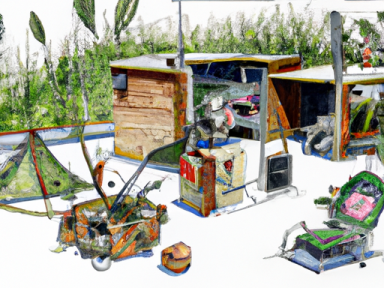
Long-Term Survival in a Bug Out Location
When it comes to survival, being prepared is key. While many people focus on short-term survival scenarios, it’s essential to consider the possibility of needing to survive for an extended period in a bug out location. Whether it’s a natural disaster, civil unrest, or a global pandemic, having a plan for long-term survival is crucial. In this article, we will explore the tactics needed to thrive in your bug out location.
1. Water
Water is the most important resource for survival. Without it, you can only last a few days. Ensure that you have a reliable source of water in your bug out location. Depending on your situation, this could be a well, nearby stream, or rainwater collection system.
It’s essential to have a way to purify water as well. Boiling, using water purification tablets, or having a portable water filter are all viable options. Remember to store enough water for each person in your group to last at least one week.
2. Food
Stocking up on non-perishable food items is vital for long-term survival. Canned goods, dehydrated meals, and foods with a long shelf life, such as rice and beans, should be a part of your emergency food supply. Consider growing your own food as well, whether it’s through gardening or raising livestock.
Learn and practice basic food preservation techniques like canning, dehydrating, and fermenting. These methods will extend the shelf life of your food supply and provide a variety of options during long-term survival situations.
3. Shelter
Your bug out location should have a sturdy shelter that can withstand various weather conditions. If possible, have a backup shelter option as well. Insulate the shelter properly to regulate temperature. Consider alternative heating and cooling methods, such as a wood stove or solar-powered fans.
Additionally, learn basic carpentry skills. Being able to repair or reinforce your shelter can make a significant difference in the long run. Stock up on building materials, tools, and equipment that will aid in shelter maintenance and repair.
4. Security
In a long-term survival situation, security becomes a significant concern. Protecting your bug out location is essential. Secure the perimeter with fences, alarms, or natural barriers like thorny bushes. Develop a plan for handling potential threats, whether it’s through a neighborhood watch system or having a trained security team.
Invest in defensive tools and weapons for self-defense. Properly maintain and practice using these items to be prepared for any eventuality. Establish a communication plan with nearby like-minded individuals to ensure mutual protection and support.
5. Skills and Knowledge
Surviving long-term in a bug out location requires a wide range of skills and knowledge. Learn basic first aid and emergency medical procedures. Acquire skills in hunting, fishing, trapping, and foraging for food in the surrounding area.
Develop skills in self-sufficient living, such as gardening, animal husbandry, and food preservation. Learn about natural remedies, herbal medicine, and basic healthcare practices to treat common illnesses and injuries.
Conclusion
Surviving long-term in a bug out location requires careful planning and preparation. By ensuring you have a reliable water source, enough food, a sturdy shelter, adequate security measures, and a wide range of skills and knowledge, you will increase your chances of thriving in any long-term survival scenario.
Remember, it’s better to be over-prepared than underprepared. Take the time to assess your bug out location and make any necessary improvements. Continuously expand your knowledge and practice your skills to stay ahead of potential challenges. The future may be uncertain, but being prepared for long-term survival will give you the peace of mind you need to face it head-on.



GIPHY App Key not set. Please check settings